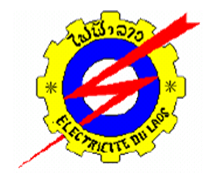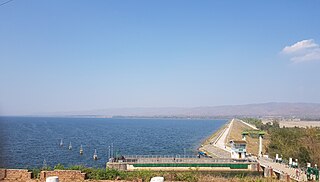Related Research Articles

The Mekong or Mekong River is a trans-boundary river in East Asia and Southeast Asia. It is the world's twelfth-longest river and the third-longest in Asia with an estimated length of 4,909 km (3,050 mi) and a drainage area of 795,000 km2 (307,000 sq mi), discharging 475 km3 (114 cu mi) of water annually. From its headwaters in the Tibetan Plateau, the river runs through Southwest China, Myanmar, Laos, Thailand, Cambodia, and southern Vietnam. The extreme seasonal variations in flow and the presence of rapids and waterfalls in the Mekong make navigation difficult. Even so, the river is a major trade route between Tibet and Southeast Asia. The construction of hydroelectric dams along the Mekong in the 2000s through the 2020s causes serious problems for the river's ecosystem, including the exacerbation of drought.

Dams and reservoirs in Laos are the cornerstone of the Lao government's goal of becoming the "battery of Asia".

The Nam Theun 2 Hydropower Project, or simply NT2, is a hydroelectric dam on the Nam Theun River in Laos. Commercial operation of the plant began in April 2010. The scheme diverts water from the Nam Theun, a tributary of the Mekong River, to the Xe Bang Fai River, enabling a generation capacity of 1,075 MW, from a 350 m (1,148 ft) difference in elevation between the reservoir and the power station.
The Nam Ngum Dam is a hydroelectric dam on the Nam Ngum River, a major tributary of the Mekong River in Laos. It was the first hydropower dam built in the Lao PDR.

Électricité du Laos(EDL) is the state corporation of Laos that owns and operates the country's electricity generation, electricity transmission and electricity distribution assets. The company also manages the import and export of electricity from the national electricity grid of the country. EDL was founded in 1959 and is headquartered in Vientiane.

There are almost 200 large dams in Myanmar. Myanmar (Burma) has a large hydroelectric power potential of 39,000 megawatts (52,000,000 hp), although the economical exploitable potential is about 37,000 megawatts (50,000,000 hp). Between 1990 and 2002, the country tripled its installed capacity of hydro plants, increasing from 253 megawatts (339,000 hp) to 745 megawatts (999,000 hp). Total installed capacity in 2010 is at least 2,449 megawatts (3,284,000 hp) MW, 6% of potential. Several large dams are planned to increase future hydro utilization.

The estimated hydropower potential of Mekong River Basin about 58,930 Megawatts (MW). As of February 2024, there are an estimated 167 Hydropower Plants (HPPs) in the Mekong, with a combined installed capacity of some 36,376.3 MW. An additional 20 HPPs are currently under construction and at various stages of completion. These have a combined installed capacity of an additional 4,535.5 MW.

The Sirindhorn Dam is in Sirindhorn District, Ubon Ratchatani, Thailand. It impounds the Lam Dom Noi River, and its reservoir is the province's largest water resource. The dam was commissioned in 1971 to serve as a hydropower facility as well as to supply irrigation water. The dam was named after Princess Royal Sirindhorn. All of the electricity generated by the dam is destined for domestic markets. The dam was constructed and is owned and operated by the Electricity Generating Authority of Thailand and is located in the Mekong River Basin, just upstream from the controversial Pak Mun Dam.
The Sambor Dam is a proposed dam and hydroelectric power station on the Mekong River south of Sambor village in Prek Kampi District, Kratie Province, Cambodia. If built, it would be the lowest dam of the Mekong's mainstream dams, and largest in Cambodia.
The Lam Takhong Dam is an embankment dam on the Lam Takhong River between Pak Chong District and Sikhio District in Nakhon Ratchasima Province, Thailand. The dam was originally constructed in 1974 for the purposes of irrigation and water supply but after 2002, its water storage also serves as the lower reservoir for the Lam Takhong pumped storage power plant, Thailand's first power plant of that type.

The Ubol Ratana Dam, formerly known as the "Phong Neeb Dam", is a multi-purpose dam in tambon Khok Sung, Ubolratana district, approximately 50 km (31 mi) north of Khon Kaen, Khon Kaen province, Thailand. It was the first hydroelectric power project developed in Thailand's northeastern area of Isan. The dam impounds the Nam Phong, which flows into the Chi River and thence to the Mun River, a tributary of the Mekong River. The dam was given its current name by royal permission in 1966, in honour of princess Ubol Ratana, the eldest child of King Bhumibol Adulyadej.

The Xayaburi Dam is a run-of-river hydroelectric dam on the Lower Mekong River, approximately 30 kilometres (19 mi) east of Sainyabuli (Xayaburi) town in northern Laos. Commercial operation of the dam started in October 2019. The main purpose of the dam is to produce hydroelectric power, 95% of which is to be purchased by the Electricity Generating Authority of Thailand (EGAT). The project is surrounded in controversy due to complaints from downstream riparians and environmentalists. Preliminary construction began in early-2012, but work on the dam itself was suspended shortly thereafter due to complaints from Cambodia and Vietnam downstream. After making modifications to the dam's design, Laos started construction with a ceremony on 7 November 2012. The Xayaburi Dam is the first of the 11 dams planned on the lower Mekong.
The Don Sahong is a hydroelectric dam commissioned in 2020 on the Mekong River in Siphandone area of Champasak Province, Laos, less than two kilometers upstream of the Laos–Cambodia border.
The Houay Ho is a dam located in the Samakkhixay District of Attapeu Province, Laos, 160 km (99 mi) east of Pakse and 30 km (19 mi) northwest of Attapeu. The project is considered the first privately financed joint venture 'build-operate-transfer' (BOT) hydropower project in Laos. It has installed capacity of 152.1 megawatts (204,000 hp), almost all of which is exported to Thailand.
This page describes energy and electricity production, consumption and import in Laos.
Renewable energy in Thailand is a developing sector that addresses the country’s present high rate of carbon emissions. Several policies, such as the Thirteenth Plan or the Alternative Energy Development Plan, set future goals for increasing the capacity of renewable energy and reduce the reliance of nonrenewable energy. The major sources of renewable energy in Thailand are hydro power, solar power, wind power, and biomass, with biomass currently accounting for the majority of production. Thailand’s growth is hoped to lead to renewable energy cost reduction and increased investment.
Thailand has set targets and policies for the development of its energy sector for 2035, with priority being given to indigenous renewable energy resources, including hydropower.
Vietnam utilizes four main sources of renewable energy: hydroelectricity, wind power, solar power and biomass. At the end of 2018, hydropower was the largest source of renewable energy, contributing about 40% to the total national electricity capacity. In 2020, wind and solar had a combined share of 10% of the country's electrical generation, already meeting the government's 2030 goal, suggesting future displacement of growth of coal capacity. By the end of 2020, the total installed capacity of solar and wind power had reached over 17 GW. Over 25% of total power capacity is from variable renewable energy sources. The commercial biomass electricity generation is currently slow and limited to valorizing bagasse only, but the stream of forest products, agricultural and municipal waste is increasing. The government is studying a renewable portfolio standard that could promote this energy source.

The Nam Ou cascade hydropower project is a series of seven hydroelectric dams along the Nam Ou river which are located in the provinces of Phongsaly and Luang Prabang in northern Laos. The project is managed by the Power Construction Corporation of China (PowerChina) and the Lao government. The project is the series of dams include seven levels of reservoirs in an attempt to mitigate ecological deterioration. The construction of the hydropower project is being completed in two phases. Phase I of the dams, including Nam Ou 2, Nam Ou 5, and Nam Ou 6 began operating on May 12, 2016. Phase II of the dams, including Nam Ou 1, 3, 4, and 7 is expected to be completed in 2020.
References
- ↑ "Thailand Aims to Be Southeast Asia's Power-Trading Middleman". Bloomberg. Retrieved 2019-08-26.
- 1 2 "WLE, 2016. Dataset on the Dams of the Irrawaddy, Mekong, Red and Salween River Basins. Vientiane, Lao PDR: CGIAR Research Program on Water, Land and Ecosystems - Greater Mekong". CGIAR Research Program on Water, Land and Ecosystems (Greater Mekong). Retrieved 2018-04-04.